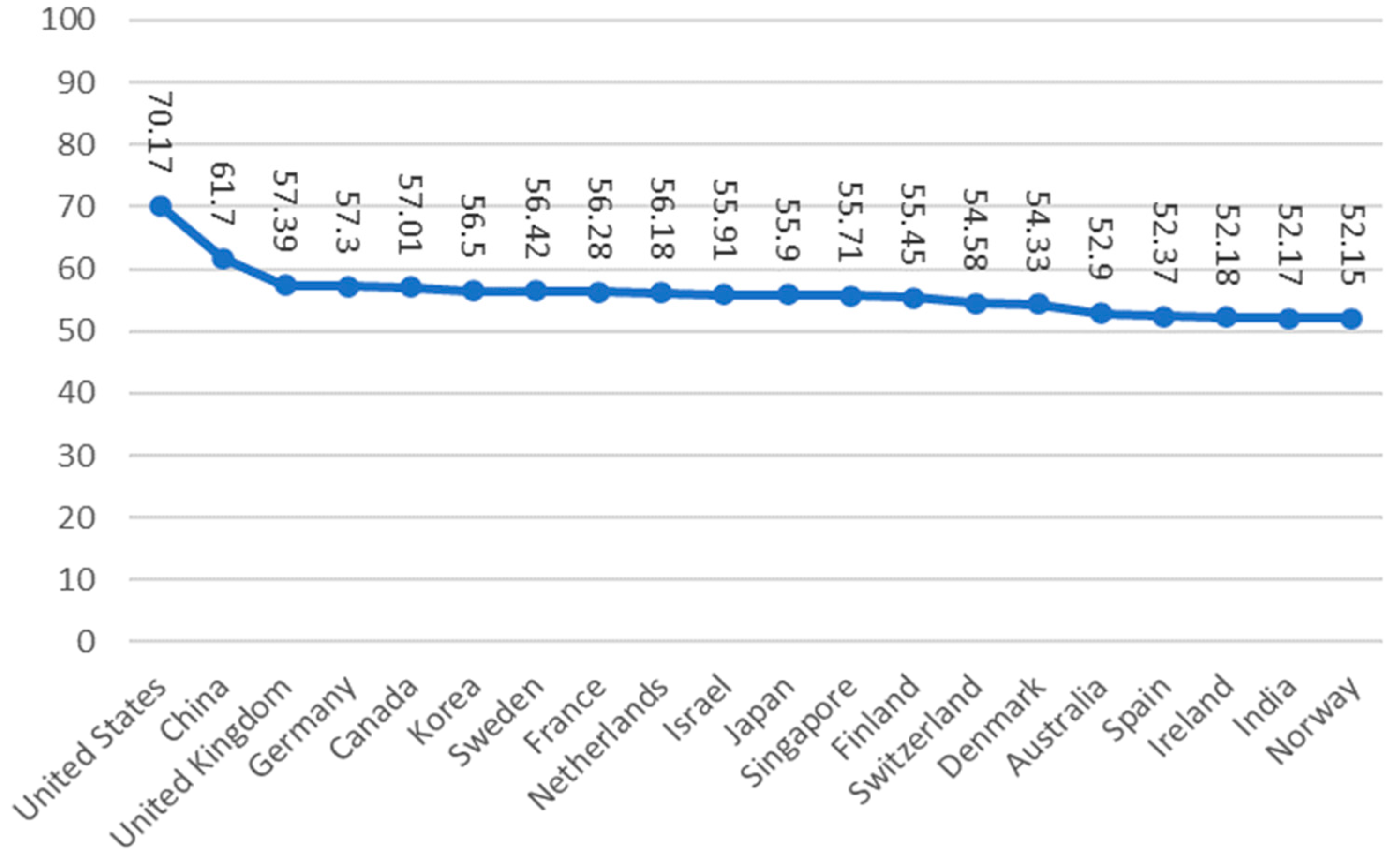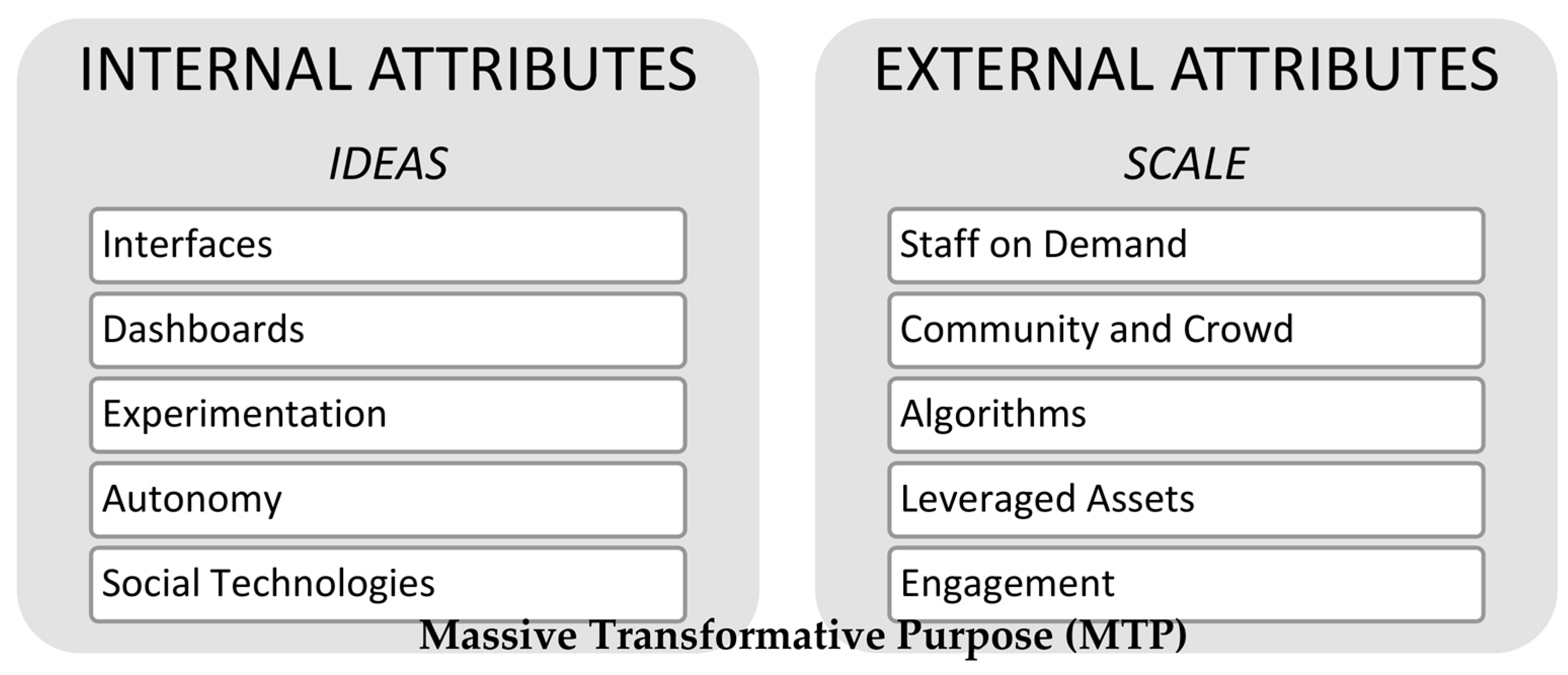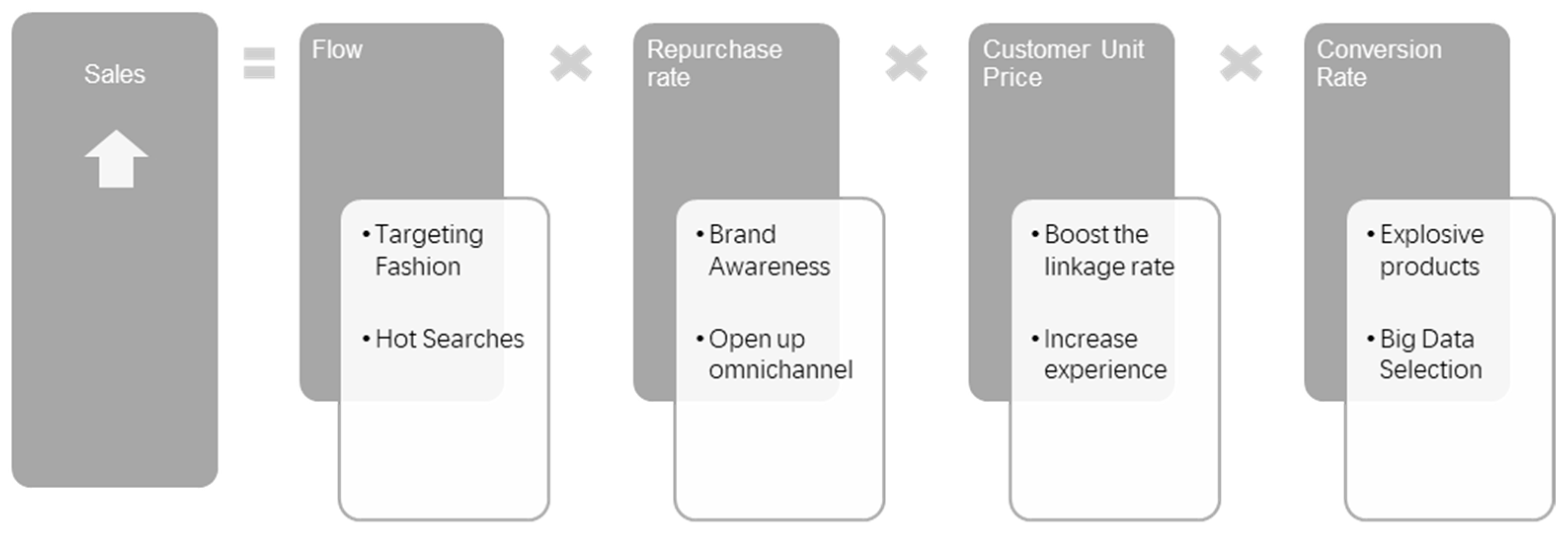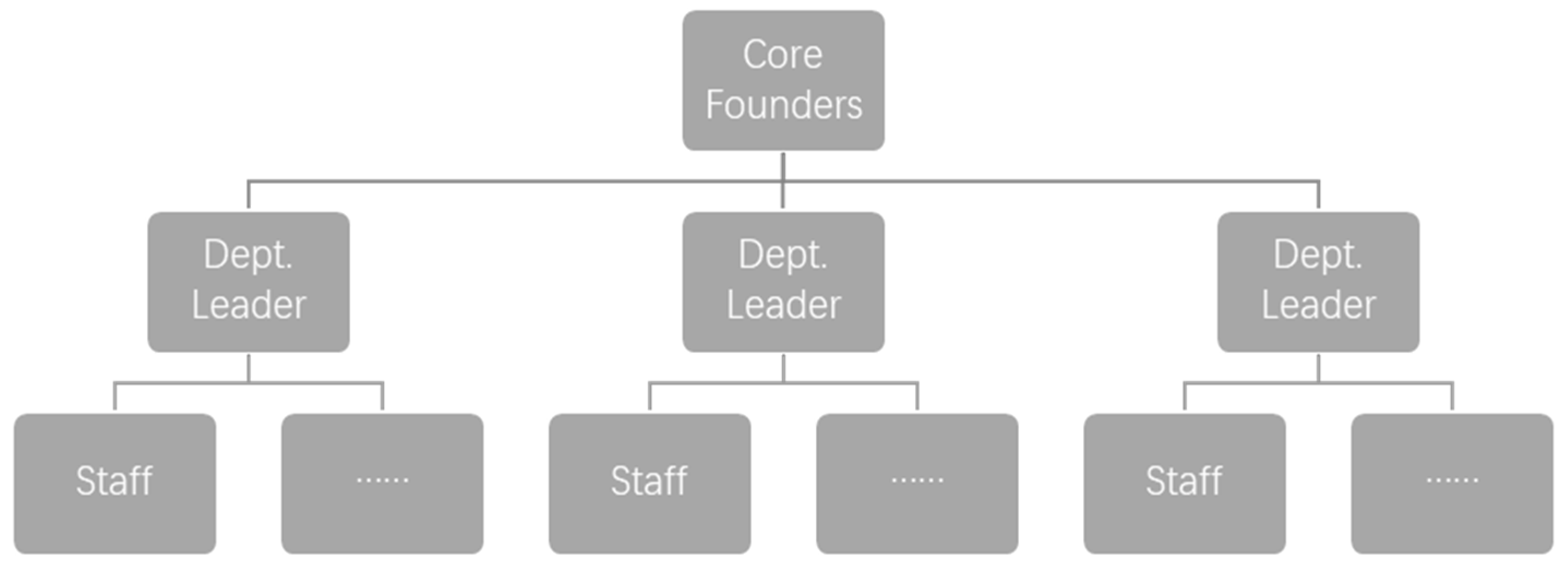Business Model Innovation of Exponential Organizations: The Case of Xiaomi
Abstract
1. Introduction
2. Literature Review
2.1. Exponential Organizations
2.2. Semi-Structured Interviews
2.3. Exponential Organizations’ Business Model
3. Research Design
3.1. Methodology
3.2. Data Collection
4. Case Description
4.1. Case Selection
4.2. Case Study Framework
4.2.1. Value Proposition
4.2.2. Value Creation
4.2.3. Value delivery
Marketing
Sales
4.2.4. Organization and Management
4.2.5. Value Capture
5. Discussion
- Exponential organizations are effective in using public recourse for their creativity, innovation, validation, and even crowdfunding, and they use the Internet platforms to complete the overall process. This research result is highly consistent with the research of Ismail (2014) [1] and Diamandis (2016) [7]. Consistent with the current business model of Internet organizations and relative to the Priyono (2020) [52] study, we found that the transformation of organizations can be achieved more effectively through public resources.
- Exponential organizations have strong computer science R&D ability and develop their algorithms. They use data-driven, accurate prediction of production, sales, and service patterns. Exponential organizations actively use new media and Internet technology to promote their brand and understand the usage habits of contemporary people, and offer the suitable interfaces for use. This finding complements Raju and Holm’s [43] research on leadership for organizational growth, which concludes that computer science is also a pathway to organizational growth.
Exponential Organizations’ Attributes and Degree of Innovation Contribution
6. Conclusions and Prospects
- There are three main characteristics of exponential organizations that can effectively help the organization achieve significant results in building an innovation ecosystem: Community and Crowd, Algorithms, and Leveraged Assets. Community and Crowd means that exponential organizations can effectively use external resources through the Internet platform to help enterprises innovate internally. Algorithms are used to help organizations to predict future development and innovation directions more accurately, with the aid of computer science and driven by data. Leveraged Assets means that exponential organizations seek common development through cooperation with partners based on complementary strengths and mutual benefits.
- This study argues that the 11 attributes of exponential organizations delineate a more segmented dimension for business model innovation, making it easier for organizations to choose the right direction for themselves in business model innovation and allowing them to be more focused on the innovation process.
Author Contributions
Funding
Institutional Review Board Statement
Informed Consent Statement
Data Availability Statement
Conflicts of Interest
References
- Ismail, S. Exponential Organizations: Why New Organizations Are Ten Times Better, Faster, and Cheaper than Yours and What to Do about It? Diversion Books: New York, NY, USA, 2014. [Google Scholar]
- Yan, H. What is the exponential thinking that has created so many unicorns? Zhongguo Shangren 2018, 5, 36–40. [Google Scholar]
- Loonam, J.; Eaves, S.; Kumar, V.; Parry, G. Towards digital transformation: Lessons learned from traditional organizations. Strateg. Chang. 2018, 27, 101–109. [Google Scholar] [CrossRef]
- Ismail, S. How large companies are moving closer to exponential organizations. Tsinghua Bus. Rev. 2016, 12, 29–36. [Google Scholar]
- Chen, J. Build an Exponential Enterprise; Enterprise Management: Beijing, China, 2017; Volume 4, pp. 6–9. [Google Scholar]
- Amini, M.; Bienstock, C.; Narcum, J. Status of Corporate Sustainability: A Content Analysis of Fortune 500 Companies. Bus. Strategy Environ. 2018, 27, 1450–1461. [Google Scholar] [CrossRef]
- Diamandis, P. The exponential organization that will win the future. IT Manag. World 2016, 64–65. Available online: https://kns.cnki.net/kcms2/article/abstract?v=3uoqIhG8C44YLTlOAiTRKibYlV5Vjs7ijP0rjQD-AVm8oHBO0FTadk7EPfJP5vmyZxZWo6PXhQn0nGQnUAMQLVGZEfJzUF5C&uniplatform=NZKPT (accessed on 28 December 2022).
- Dandan, R. An Empirical Study on the Influence of Board Characteristics on Corporate Performance—Analysis from the Perspective of Index Organization; Shandong Normal University: Shandong, China, 2020. [Google Scholar]
- Rufini, F. Going Exponential: Growth Strategies for Business Leveraging the Exponential Organization Model. Master Thesis, Libera Università Internazionale degli Studi Sociali Guido Carli, Rome, Italy, 2018. [Google Scholar]
- The World Bank. World Internet Development Report 2021; The World Bank: New York, NY, USA, 2021. [Google Scholar]
- Sandel, T.; Fitzgerald, R. Understanding Chinese internet and social media: The innovative and creative affordances of technology, language and culture. Cah. Cent. Linguist. Sci. Lang. 2019, 59, 161–177. [Google Scholar]
- Du, S.M. Effect of Digital Enablement of Business-to-Business Exchange on Customer Outcomes: The Role of Information Systems Quality and Relationship Characteristics; Georgia State University: Atlanta, GA, USA, 2010. [Google Scholar]
- Marina, D.-P.; Ortega-Fernández, F.; Morán-Palacios, H.; Rodríguez-Montequín, V. Monitoring the Implementation of Exponential Organizations through the Assessment of Their Project Portfolio: Case Study. Sustainability 2021, 13, 464. [Google Scholar]
- Guo, Y.; Zhu, Y.; Chen, J. Business Model Innovation of IT-Enabled Customer Participating in Value Co-Creation Based on the Affordance Theory: A Case Study. Sustainability 2021, 13, 5753. [Google Scholar] [CrossRef]
- Dellaert, B.G. The consumer production journey: Marketing to consumers as co-producers in the sharing economy. J. Acad. Mark. Sci. 2019, 47, 238–254. [Google Scholar] [CrossRef]
- Alfaouri, R.; Alshammari, H.; Tubaishat, H. Exponential Organizations Hypergrowth Strategies and Firm Performance: The Moderating Role of Firm Size and Marketing Spending. Int. J. Manag. Humanit. 2021, 5, 112–121. [Google Scholar]
- Pu, Y. Build an Exponential Organization. Heilongjiang Dly. 2017. Available online: https://d.wanfangdata.com.cn/periodical/ChlQZXJpb2RpY2FsQ0hJTmV3UzIwMjMwMzIxEg1xeWdsMjAxNzA0MDAyGghkMnlmbnZtYg%3D%3D (accessed on 28 December 2022).
- Merton, R.K.; Kendall, P.L. The focused interview. Am. J. Sociol. 1946, 51, 541–557. [Google Scholar] [CrossRef]
- McIntosh, M.J.; Morse, J.M. Situating and constructing diversity in semi-structured interviews. Glob. Qual. Nurs. Res. 2015, 2, 2333393615597674. [Google Scholar] [CrossRef]
- Bartholomew, K.; Henderson, A.J.; Marcia, J.E. Coded semistructured interviews in social psychological research. In Handbook of Research Methods in Social and Personality Psychology; Cambridge University Press: Cambrigde, UK, 2000. [Google Scholar]
- Donner, M.; Gohier, R.; de Vries, H. A New Circular Business Model Typology for Creating Value from Agro-Waste. Sci. Total Environ. 2020, 716, 137065. [Google Scholar] [CrossRef] [PubMed]
- Osterwalder, A.; Pigneur, Y. Business Model Geberation; Kompas Gramedia: Jakarta, Indonesia, 2014. [Google Scholar]
- Xin, W. Mobile Internet Business Model Discussion. J. Chongqing Univ. Posts Telecommun. 2009, 21, 2009. [Google Scholar]
- Afuah, A.; Tucci, C.L. Internet Business Models and Strategies: Text and Cases; McGraw-Hill: New York, NY, USA, 2003; Volume 4. [Google Scholar]
- Huisheng, L.Q.; Wang, H. Value-Based Internet Business Model Design. J. Beijing Univ. Posts Telecommun. 2010, 12, 48–55. [Google Scholar]
- Xiaodan, Z. Exploration of the Profit Model of China’s Internet Economy. Mark. Manag. Gard. 2015, 7, 14–15. [Google Scholar]
- Osterwalder, A.; Pigneur, Y. Business Model Generation: A Handbook for Visionaries, Game Changers, and Challengers; John Wiley & Sons: Hoboken, NJ, USA, 2010; Volume 1. [Google Scholar]
- Teece, D.J. Business models, business strategy and innovation. Long Range Plan. 2010, 43, 172–194. [Google Scholar] [CrossRef]
- Trimi, S.; Berbegal-Mirabent, J. Business model innovation in entrepreneurship. Int. Entrep. Manag. J. 2012, 8, 449–465. [Google Scholar] [CrossRef]
- Yael, D.; Orit, H. Agile exponential software organizations. In Proceedings of the 2019 IEEE/ACM 41st International Conference on Software Engineering: Software Engineering in Practice (ICSE-SEIP), Montreal, QC, Canada, 27 May 2019. [Google Scholar]
- Bocken, N.M.; Short, S.W.; Rana, P.; Evans, S. A literature and practice review to develop sustainable business model archetypes. J. Clean. Prod. 2014, 65, 42–56. [Google Scholar] [CrossRef]
- Anderson, C. The Long Tail: Why the Future of Business Is Selling Less of More; Hachette: London, UK, 2006. [Google Scholar]
- Zott, C.; Amit, R.; Massa, L. The business model: Recent developments and future research. J. Manag. 2011, 37, 1019–1042. [Google Scholar]
- Shafer, S.M.; Smith, H.J.; Linder, J.C. The power of business models. Bus. Horiz. 2005, 48, 199–207. [Google Scholar] [CrossRef]
- Yin, R.K. Case Study Research: Design and Methods; Sage Publications: New York, NY, USA, 2009; Volume 5. [Google Scholar]
- Xiaomi Corporation. Annual Report 2015–2021. Available online: https://ir.mi.com/financial-information/annual-interim-reports (accessed on 28 December 2022).
- Ruyi, W.; Qiong, L. Research on Xiaomi’s Internationalized Business Model. Open J. Bus. Manag. 2021, 9, 1050. [Google Scholar]
- Nora Andira, B. The Effect of Brand Page Commitment, Brand Awareness, Electronic Word Of Mouth and Brand Image on Purchase Intention of Xiaomi Smartphone on Social Media. GATR J. Manag. Mark. Rev. 2021, 6, 4. [Google Scholar]
- Ortiz, J.; Ren, H.; Li, K.; Zhang, A. Construction of Open Innovation Ecology on the Internet: A Case Study of Xiaomi (China) Using Institutional Logic. Sustainability 2019, 11, 3225. [Google Scholar] [CrossRef]
- Kim, S.H. Emergence and Success of Xiaomi in the Transitional Situation of Chinese Smartphone Industry. East Asian J. Bus. Econ. 2018, 6, 16–23. [Google Scholar] [CrossRef]
- Panigrahi, A. A Case Study on Marketing Strategy of Xiaomi. Int. J. Manag. Technol. Soc. Sci. 2019, 4, 2581–6012. [Google Scholar] [CrossRef]
- Huaqiao, X. The Exponential Organization and Innovation Perpetual Motion Redefine the Company. Coprorate Financ. 2020, 5, 38–40. [Google Scholar]
- Raju, M.A.U.; Holm, J.R. The Role of Business Model Innovation and Leadership for Start-Up Growth: A Case Study of Xiaomi. Master Thesis, Aalborg Univeristy, Aalborg, Denmark, 2019. [Google Scholar]
- Hongjia Yu, G.L.; Li, S.; Wang, D. Global Logistics Supply Chain Analysis-Take Xiaomi Company as an Example. Learn. Educ. 2021, 10, 2463. [Google Scholar]
- Hongyu, L. Nanxingheng Xiaomi profit model innovation study. J. Lanzhou Univ. Financ. Econ. 2019, 35, 108–116. [Google Scholar]
- Meng, Q.; Hang, Y.; Chen, X. User roles in virtual community of crowdsourcing for innovation: A case study of Xiaomi MIUI in China. Teh. Vjesn. 2019, 26, 1392–1399. [Google Scholar]
- Monden, Y. Toyota Production System: An Integrated Approach to Just-in-Time; CRC Press: Boca Raton, FL, USA, 2011. [Google Scholar]
- Grünwald, H.J.; Fortuin, L. Many steps towards zero inventory. Eur. J. Oper. Res. 1992, 59, 359–369. [Google Scholar] [CrossRef]
- Thomas, C.G.; Devi, A.J. Study and Analysis of the Influence of UX in MIUI—A Case Study on Xiaomi. Int. J. Case Stud. Bus. IT Educ. 2021, 5, 156–168. [Google Scholar]
- Jielin, D.; Juan, C. Seamless open innovation: The product innovation model of Xiaomi in the internet ecosystem. Sci. Res. Manag. 2014, 35, 76. [Google Scholar]
- Marine Corps Warfighting Laboratory. Is the Marine Corps Ready to Become an Exponential Organization? Marine Corps Warfighting Laboratory: Quantico, VA, USA, 2018; p. 102. [Google Scholar]
- Priyono, A.; Moin, A.; Putri, V.N.A.O. Identifying digital transformation paths in the business model of SMEs during the COVID-19 pandemic. J. Open Innov. Technol. Mark. Complex. 2020, 6, 104. [Google Scholar] [CrossRef]
- Alves, A.C. China’s ‘win-win’cooperation: Unpacking the impact of infrastructure-for-resources deals in Africa. S. Afr. J. Int. Aff. 2013, 20, 207–226. [Google Scholar] [CrossRef]
- Will, M.G. Successful organizational change through win-win: How change managers can create mutual benefits. J. Account. Organ. Chang. 2015, 11, 193–214. [Google Scholar] [CrossRef]
- Coccia, M. Sources of technological innovation: Radical and incremental innovation problem-driven to support competitive advantage of firms. Technol. Anal. Strateg. Manag. 2017, 29, 1048–1061. [Google Scholar] [CrossRef]
- Xinhuawang. Lark Becomes a Collaboration Tool for Tens of Thousands of Xiaomi Employees. 2020. Available online: http://www.xinhuanet.com/tech/2020-07/24/c_1126281914.htm (accessed on 28 December 2022).
- Nyameshchuk, A. The fragility as a Strategic problem of global exponential organizations. Econ. Scope 2019, 152. [Google Scholar] [CrossRef]
- Orit, H.; Yael, D. A biomimicry perspective at agile software exponential organizations. In Proceedings of the 2019 IEEE/ACM 12th International Workshop on Cooperative and Human Aspects of Software Engineering (CHASE), Montreal, QC, Canada, 27 May 2019. [Google Scholar]





| Data Sources | Data Classification | Quantity | Code |
|---|---|---|---|
| Internal information | Internal organization documents, interview | 2 | I1 |
| Enterprise Listing Annual Reports (2015–2021) | 1 | I2 | |
| Videos and books for business executives | 9 | I3 | |
| External information | Industry analysis reports | 4 | E1 |
| Other related books, cases, papers | 28 | E2 |
| Product Planning | Product Design | Product Development | Product Testing | Product Release | |
|---|---|---|---|---|---|
| Community and Crowd | Xiaomi employees spend at least half an hour every day on user forums and social networking sites to interact with users and understand their product requirements. | Numerous channels are provided for users to offer Xiaomi suggestions, invite users to participate in the use of test versions, and rapid iterative development (Experimentation). | Users volunteer to participate in the development of the product and can develop additional applications on the MIUI platform. | Xiaomi has an entirely peer-to-peer service platform, driven and organized by users, facilitating enthusiasts to participate in product testing. | Xiaomi organizes special events for a community of 46 million fans and hosts comprehensive product launches similar to those held by Google and Apple. |
| Year | 2021 | 2020 | 2019 | 2018 | 2017 | 2016 | 2015 |
|---|---|---|---|---|---|---|---|
| Marketing Expenses (Billion RMB) | 20.98 | 14.54 | 10.38 | 7.99 | 5.23 | 3.02 | 1.91 |
| Total Revenue (Billion RMB) | 328.31 | 245.87 | 205.84 | 174.92 | 114.61 | 68.43 | 66.81 |
| Marketing Expenses as a Percentage of Total Revenue | 6.39% | 5.91% | 5.04% | 4.57% | 4.56% | 4.41% | 2.86% |
| Model | Price | TTM |
|---|---|---|
| Xiaomi 1 | 1999 | 2011 |
| Xiaomi 2 | 1999 | 2012 |
| Xiaomi 3 | 1999 | 2013 |
| Xiaomi 4 | 1999 | 2014 |
| Xiaomi 5 | 1999 | 2016 |
| Xiaomi 6 | 2499 | 2017 |
| Xiaomi 8 | 2699 | 2018 |
| Xiaomi 9 | 2999 | 2019 |
| Xiaomi 10 | 3999 | 2020 |
| Xiaomi 11 | 3999 | 2020 |
| Xiaomi 12 | 3199 | 2021 |
| Year | 2021 | 2020 | 2019 | 2018 | 2017 | 2016 | 2015 |
|---|---|---|---|---|---|---|---|
| EBIT (Billions) | 24.42 | 21.63 | 12.16 | 13.93 | −41.83 | 1.18 | −7.47 |
| Gross profit (Billions) | 58.26 | 36.75 | 28.55 | 22.19 | 15.15 | 7.25 | 2.70 |
| Total revenues (Billions) | 328.31 | 245.87 | 205.84 | 174.92 | 114.61 | 68.43 | 66.81 |
| Financing Rounds | Time | Funding Agency | Amount $ |
|---|---|---|---|
| E | 2015.4 | Singapore Government, Houpu Capital, All-Stars Investment, Yunfeng Capital, DST | 1.1 B |
| D | 2013.9 | DST | Unpublished |
| C | 2012.6 | DST, Temasek | 216 M |
| B | 2011.12 | IDG, Qiming Venture Partners, Qualcomm, Temasek, 5Y Capital | 90 M |
| A | 2011.7 | IDG, Qiming Venture Partners, Shunwei Capital, 5Y Capital | 41 M |
| Element | Exponential Organizations (Xiaomi) | Traditional Organizations (Cell Phone) |
|---|---|---|
| Value proposition | Involving users actively in the product innovation process. | The user is only the purchaser of the product. |
| Value creation |
|
|
| Value delivery |
|
|
| Value capture |
|
|
| Attributes | Description | Incremental Innovation | Radical Innovation |
|---|---|---|---|
| MTP | Innovation for everyone | ||
| Interfaces | Xiaomi app store provides millions of applications | √ | |
| Dashboards | Use of frontend ideas and quality to build backend, visual management | √ | |
| Experimentation | Rapid iterative development | √ | |
| Autonomy | Flat organizational structure, decentralized management model, dynamic job roles | √ | |
| Social Technologies | Maintaining attendance using the lark system for internal–remote interactions [56] | √ | |
| Staff on Demand | Outsourcing aftersales, maintenance, and other services | √ | |
| Community and Crowd | Invite customers to participate in every aspect of product R&D | √ | |
| Algorithms | The Cloud-ML platform is the technical foundation for much of Xiaomi’s smart hardware | √ | |
| Leveraged Assets | Outsourced manufacturing | √ | |
| Engagement | Customers participate in a game to win discount coupons | √ |
Disclaimer/Publisher’s Note: The statements, opinions and data contained in all publications are solely those of the individual author(s) and contributor(s) and not of MDPI and/or the editor(s). MDPI and/or the editor(s) disclaim responsibility for any injury to people or property resulting from any ideas, methods, instructions or products referred to in the content. |
© 2023 by the authors. Licensee MDPI, Basel, Switzerland. This article is an open access article distributed under the terms and conditions of the Creative Commons Attribution (CC BY) license (https://creativecommons.org/licenses/by/4.0/).
Share and Cite
Zhang, X.; Chun, D. Business Model Innovation of Exponential Organizations: The Case of Xiaomi. Sustainability 2023, 15, 5738. https://doi.org/10.3390/su15075738
Zhang X, Chun D. Business Model Innovation of Exponential Organizations: The Case of Xiaomi. Sustainability. 2023; 15(7):5738. https://doi.org/10.3390/su15075738
Chicago/Turabian StyleZhang, Xuming, and Dongphil Chun. 2023. "Business Model Innovation of Exponential Organizations: The Case of Xiaomi" Sustainability 15, no. 7: 5738. https://doi.org/10.3390/su15075738
APA StyleZhang, X., & Chun, D. (2023). Business Model Innovation of Exponential Organizations: The Case of Xiaomi. Sustainability, 15(7), 5738. https://doi.org/10.3390/su15075738







